MIGHTY NINETY
Task Force 38 attacked off Formosa
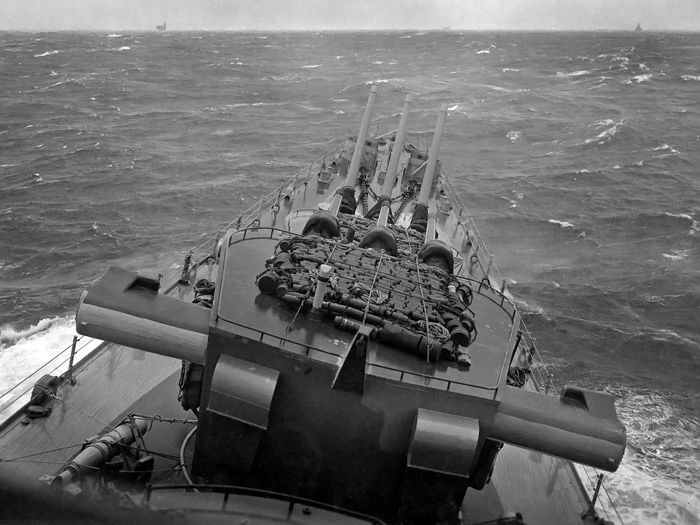
USS ASTORIA rolls to starboard in rough seas on 19 January 1945. The turret one guns are elevated to prevent water from flooding the barrels when the ship plunges into troughs.
-photo taken by and courtesy of Herman Schnipper
17-19 January 1945
Getting out of the South China Sea was indeed becoming a significant problem. The weather remained heavy, seas were rough, and fueling was difficult. The task force held station west of Luzon in hopes that the weather would improve. Supplies began to dwindle.
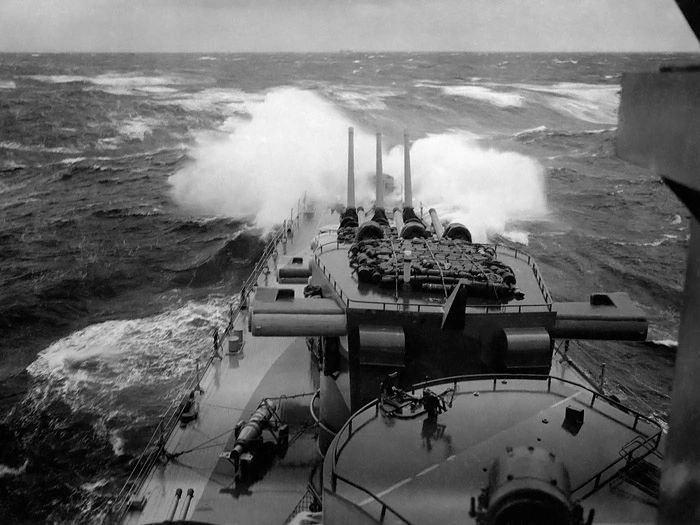
A wave crashes over the bow of ASTORIA in a second image from 19 January 1945.
-photo taken by and courtesy of Herman Schnipper
The next day offered no improvement. From Morison's The Liberation of the Philippines:
18 January proved even worse than the 17th. Fueling was impossible, and by noon Task Force 38 again had to reverse course and sail south in search of protected waters. Since fleet aerologists predicted that foul weather would continue at least through 19 January, Halsey decided that he had better fuel under the lee of Luzon that day and then leave South China Sea by Surigao Strait.
Halsey's new route out would take the fleet far to the south. Admiral Nimitz pushed back and strongly encouraged Halsey to find a way to exit the South China Sea via the northern route. Nimitz wished to minimize risk and protect the carriers from the vulnerability of straying too far from their planned area of operations. He also meant to keep them in position to strike Formosa and Okinawa.
Halsey complied with his orders, and was able to eventually fuel and supply his ships by finding a break in the weather. The task force once again headed north.

USS ASTORIA moves into position to refuel on 19 January 1945, once again in rough seas. An oiler approaches on the horizon at right.
-photo taken by and courtesy of Herman Schnipper

Sailors aboard an unidentified oiler use a capstan to provide leverage in bringing a line across from a destroyer in the South China Sea, January 1945.
-U.S. Navy photo in NARA record group 80-G-431087
20 January 1945
From Morison's The Liberation of the Philippines:
By the afternoon... Task Force 38 was heading east into Balingtang Channel, a destroyer division sweeping ahead of the three task groups. Bogeys were almost constantly on the screen, but no attack developed; and about 15 enemy planes which were evacuating air personnel from Luzon to Formosa were shot down.

A TBM Avenger lifts from the deck of USS HANCOCK on 21 January 1945. Barely visible at center, the VF-11 Hellcat of LCDR Fritz Wolf has just splashed astern of a cruiser after taking off from USS HORNET. Wolf lost fuel pressure and was forced to ditch immediately after takeoff. He was later rescued by a destroyer.
-Jerome Zerbe photo in NARA record group 80-G-308502
21 January 1945
In the early morning hours, the fast carriers took position to conduct more strikes against shipping and airfields across Formosa and the surrounding smaller islands. The Japanese airfields had been repaired and more planes shuttled in from the mainland while Halsey's ships were hunting further south over the past ten days. As the American planes launched throughout the morning, it became apparent that the weather would finally cooperate.
Planes of the Japanese Special Attack Corps based at Tainan, Formosa were taking advantage of the clear skies. As ASTORIA shipmates watched the flak bursts from a distance, Task Group 38.3 caught the worst of the attacks. At noon the light carrier USS LANGLEY was struck by two small Japanese bombs, damaging her flight deck and temporarily disrupting recovery operations. Minutes later, a suicide plane dove from out of the sun on the fleet carrier USS TICONDEROGA and crashed into her flight deck. The plane's 550-lb. bomb penetrated and detonated between the hangar and gallery decks. Intense fires broke out on TICONDEROGA's hangar deck among tightly packed, fueled planes.

The deck of TICONDEROGA from high in her superstructure shortly after she is hit on 21 January 1945. Firefighting parties run hoses at center.
-U.S. Navy photo in Brent Jones collection

Smoke pours from TICONDEROGA as planes on her flight deck catch fire, 21 January 1945. This photograph was taken from USS MIAMI CL-89 as she moved in to assist.
-U.S. Navy photo in Brent Jones Collection
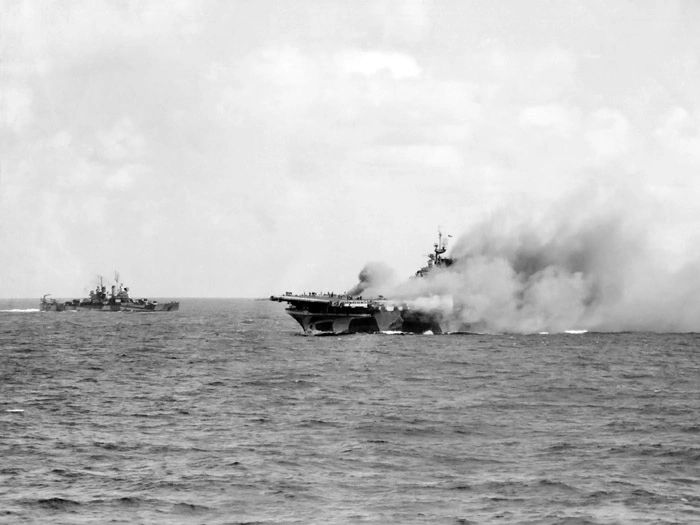
TICONDEROGA turns to starboard as MIAMI moves in to assist her.
-U.S. Navy photo in NARA record group 80-G
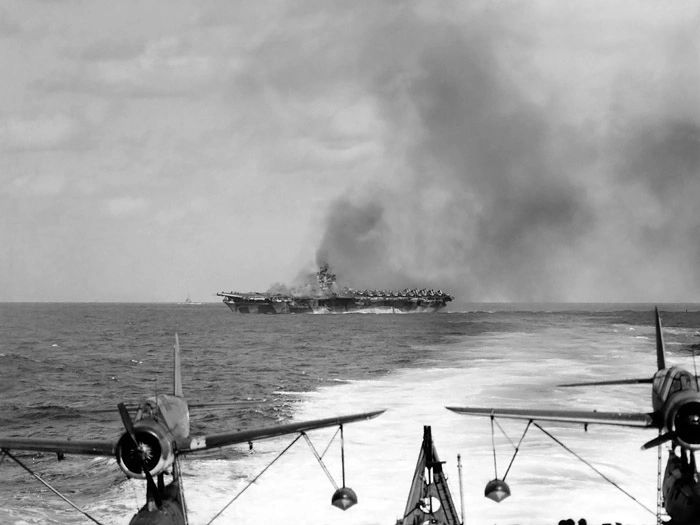
TICONDEROGA has brought her deck fires under control due to quick maneuvering and thinking from her Captain, Dixie Kiefer. The carrier has been intentionally listed to port in order to pour flaming aviation gasoline overboard. MIAMI, the source of this image, has taken position ahead of the damaged carrier.
-U.S. Navy photo in NARA record group 80-G-356986
While Task Group 38.3 fought their battle, a group of 13 enemy planes launched from Luzon approached Task Group 38.1. CAP planes from USS COWPENS intercepted them and disrupted the attack. USS ASTORIA's task group wasn't touched, insulated against attacks from Formosa in the north and Luzon in the south by the other groups.
At 1250, 13 more enemy planes from Formosa descended upon Task Group 38.3. The heavily smoking TICONDEROGA provided a clear target. Although CAP and antiaircraft screen destroyed 12 of the would-be attackers, the 13th made it through and crashed into the carrier's island superstructure at her forward fire director.

TICONDEROGA is hit by a second suicide plane, this time high in her forward director platform.
-U.S. Navy photo in NARA record group 80-G-273150
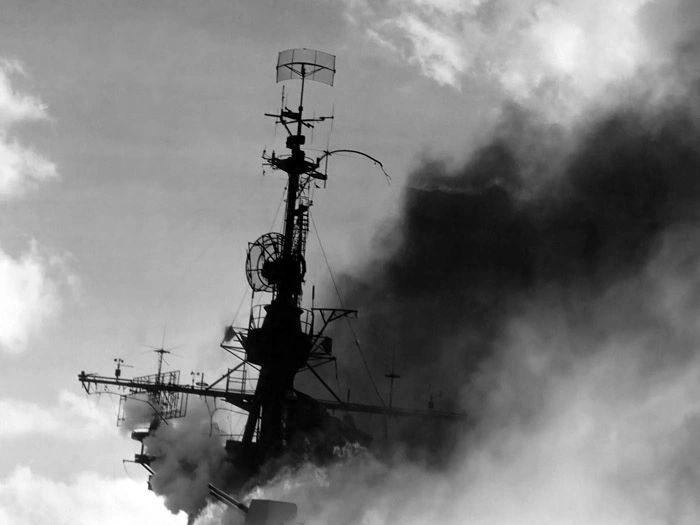
Fire rages from the upper superstructure of TICONDEROGA as she lists to port in the early afternoon of 21 January 1945.
-U.S. Navy photo in NARA record group 80-G-273230
The carnage for the task force continued, as twenty minutes later the destroyer picket USS MADDOX DD-731 was hit. She fell victim to a "Tail-end Charlie," a Japanese Zero that joined an American formation of planes returning from air strikes.
At 1328 Task Group 38.2 suffered their first casualty of the day, albeit from a different source. USS HANCOCK was recovering strike aircraft when a TBM Avenger landed with a live bomb that had failed to release from its ordnance bay. The bomb detonated on the carrier deck, immediately killing the Avenger's crew and many surrounding flight deck personnel. The explosion burst through to the gallery and hangar decks causing multiple fires.

Airborne planes from HANCOCK were unable to land as her crew fought fires on her flight deck from the bomb explosion.
-U.S. Navy photo in NARA record group 80-G-470291

The flight deck amidships of HANCOCK shortly after the explosion. The wreckage of the exploded Avenger burns at center.
-U.S. Navy photo in NARA record group 80-G
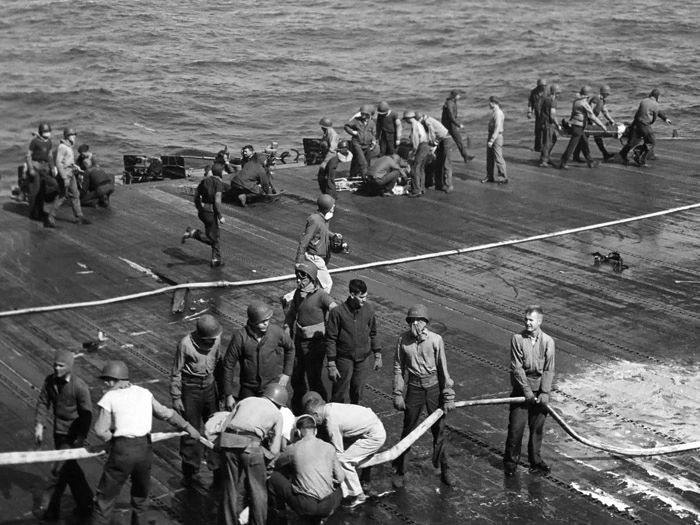
Men fight fires and tend to the wounded aboard HANCOCK on 21 January 1945.
-U.S. Navy photo in NARA record group 80-G-308476
By mid-afternoon, fires has been brought under control aboard the wounded carriers. Among the casualties was the skipper of TICONDEROGA, Captain Dixie Kiefer, badly wounded in the second attack. He was evacuated to a hospital ship.
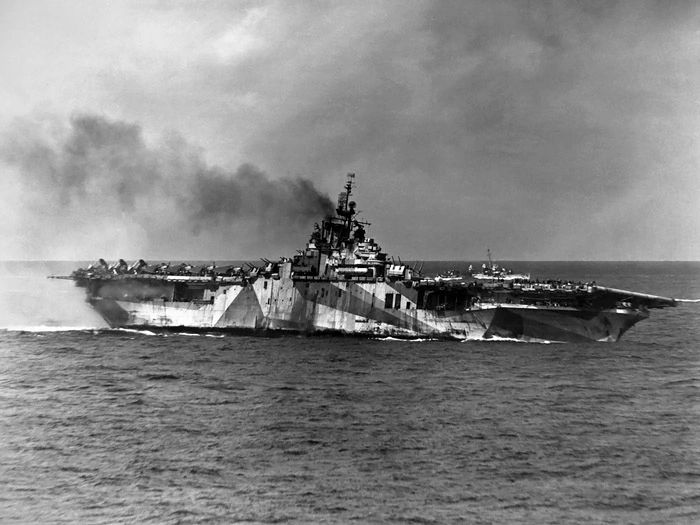
TICONDEROGA in the afternoon of 21 January 1945. Her list to port is intentional and has succeeded in dumping flaming fuel overboard. While her deck and hangar fires have been brought largely under control, her burned-out director platform continues to pour smoke.
-U.S. Navy photo in NARA record group 80-G
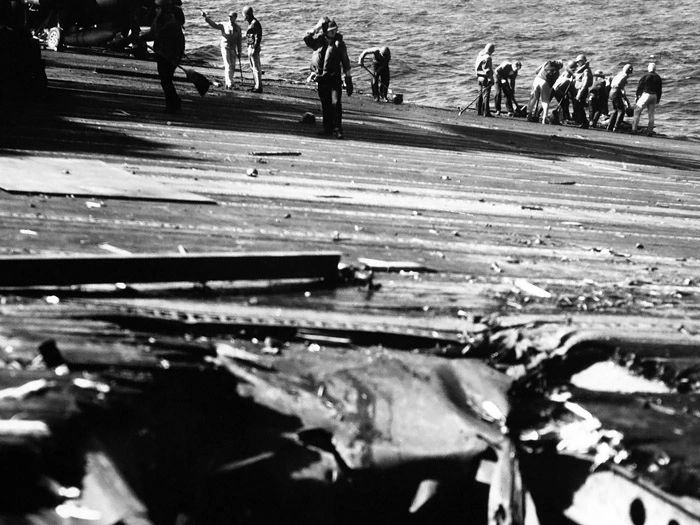
TICONDEROGA sailors clean up the mess on her flight deck. The large entry hole in the foreground illustrates the vulnerable nature of wooden decking on WWII American aircraft carriers.
-U.S. Navy photo in Brent Jones collection

USS TICONDEROGA viewed from ESSEX CV-9 shortly after her fires have been extinguished. Note the wrecked plane aboard ESSEX at right.
-U.S. Navy photo in NARA record group 80-G-273056
The Japanese attacks subsided, and by late afternoon damage control and emergency repairs had been completed. That evening TICONDEROGA and MADDOX were detached to limp back to Ulithi accompanied by two light cruisers and three destroyers.
One additional event took place on 21 January which held personal significance to the men aboard the Mighty Ninety. In the early afternoon, Kingfisher floatplanes of VCS-17 (Scout Squadron, Cruiser Division 17) were dispatched from ASTORIA and PASADENA to rescue downed airmen in the sea west of Formosa. Senior Aviator LT Charles Tanner piloted the single plane launched from ASTORIA with instructions to meet up with two planes from PASADENA and head to the site of the downed aircrew. But as the day progressed and night fell, the three planes did not return to their ships.
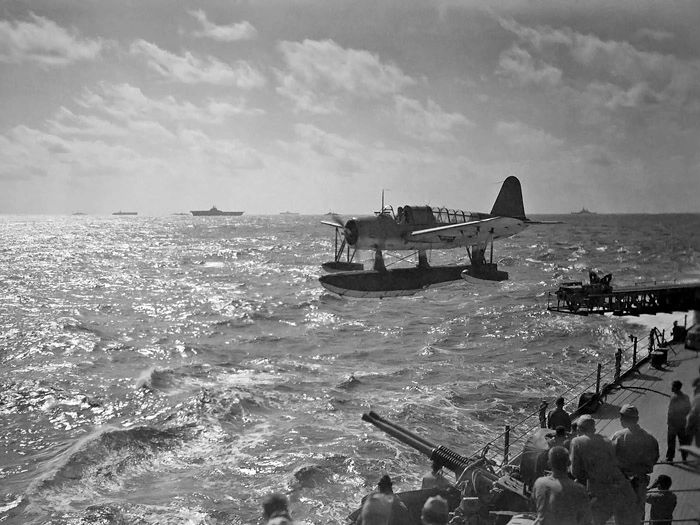
ASTORIA Sailors and Marines watch as LT Charles Tanner launches from ASTORIA's starboard catapult on 21 January 1945. His plane would not return to the ship.
-photo taken by and courtesy of Herman Schnipper
The day was both productive and costly. 1164 sorties were flown from the fast carriers, resulting in 104 enemy aircraft destroyed on the ground, more than 30 in the air, and ten Japanese merchant ships sunk. But the Japanese Special Attack Corps had managed to place a hefty price tag on these successes. A fleet carrier had been knocked out of action and 205 men were listed killed or missing in action aboard the four damaged ships. An additional 351 men were wounded.
22 January 1945
Overnight Task Force 38 steamed northeast and took up position off Okinawa. Strikes for the day targeted shipping and airfields, but the primary objective of the day's operations was to perform photographic reconnaissance in preparation for the Okinawa invasion scheduled for April.
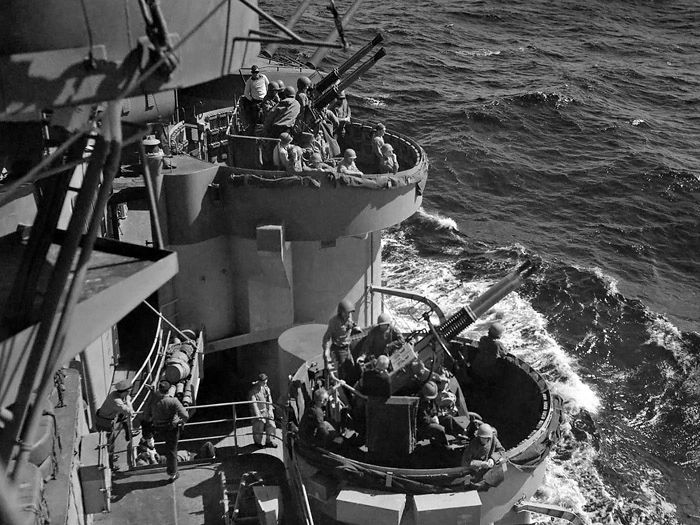
USS ASTORIA 40mm gun crews at air emergency stations off Okinawa on 22 January 1945.
-photo taken by and courtesy of Herman Schnipper
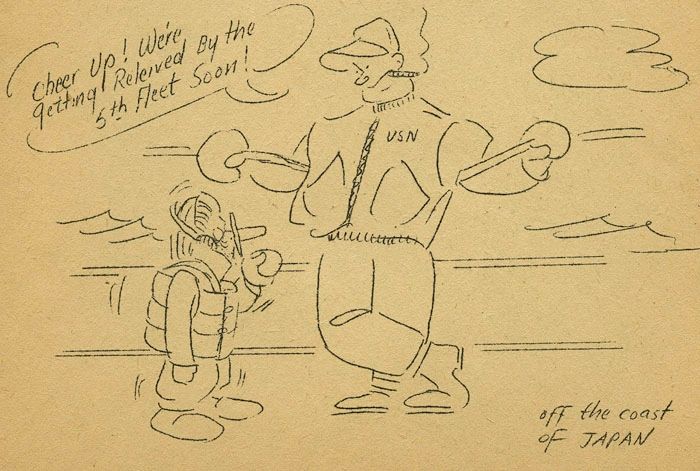
Joey Fubar, cold and wet off the coast of Japan, is informed that ASTORIA and 3rd Fleet are being relieved by 5th Fleet. The ironic humor of the cartoon is that 3rd Fleet and 5th Fleet are the same ships, just under different leadership and planning staff.
-Joe Aman cartoon courtesy of Jim Peddie
Reports were pieced together regarding the previous day's rescue mission. Word began to circulate throughout the ship regarding Senior Aviator Tanner.
As it turned out, the downed aircrew had been picked up by an American submarine on "lifeguard duty" before the VCS-17 Kingfishers could arrive. Tanner and the PASADENA pilots searched in vain for the aircrew and finally turned around. During their return trip, the PASADENA planes ran low on fuel and were forced to land on the ocean. LT Tanner made the decision to land his plane to stay with one of the PASADENA planes on the surface overnight. He had not been heard from since.
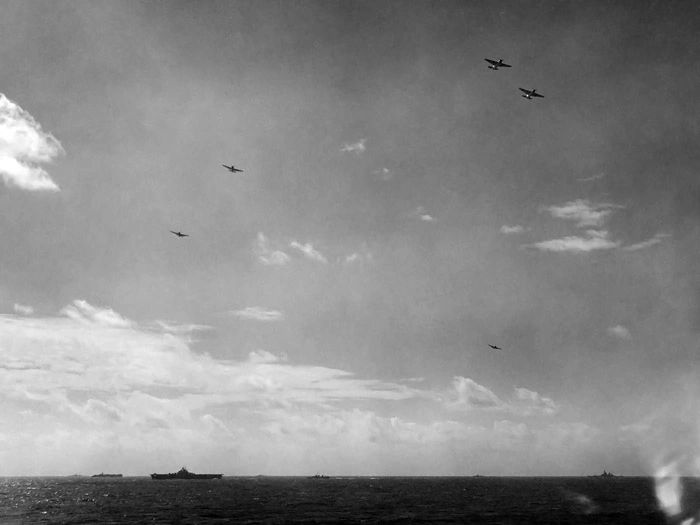
TBM Avengers over ASTORIA CL-90 and Task Group 38.2 on 22 January 1945.
-photo taken by and courtesy of Herman Schnipper
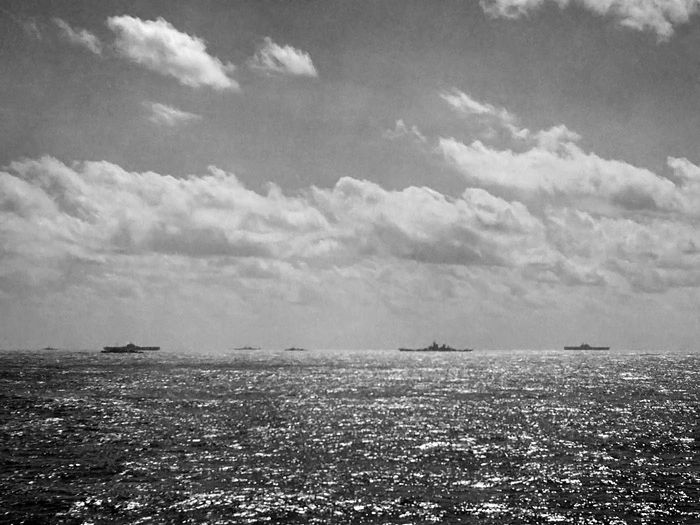
Task Group 38.2 leaves the Okinawa area in the evening of 22 January. Note night carrier ENTERPRISE CV(N)-6 moving at right with the group.
-photo taken by and courtesy of Herman Schnipper

Track chart of USS ASTORIA as Task Force 38 searches the South China Sea for a calm spot to refuel, then transits the Luzon Strait and launches strikes against Formosa and Okinawa.
-manipulated from Google Earth imagery
23-25 January 1945
Offensive operations for MIKE I and GRATITUDE completed, Task Force 38 began the long haul back to Ulithi. Although USS ASTORIA was now a combat veteran with two Battle Stars under her belt, she had yet to fire an offensive shot. Her surface fire mission against the Imperial Japanese Navy had been thwarted by the absence of ships at Cam Ranh Bay, and so far her participation in aerial attacks over the fast carriers had been limited to watching from a distance. Her excellent gunnery in practice had yet to be tested in combat.

A USS TICONDEROGA Chaplain performs last rites for the dead as Marines prepare to fire a salute circa 25 January 1945. Three Marines wear a sea detachment patch on their shoulder.
-U.S. Navy photo in NARA record group 80-G-303137

Task Group 38.2 carriers USS HORNET and INDEPENDENCE return to Ulithi on 26 January 1945 in a view from LEXINGTON CV-16.
-U.S. Navy photo in NARA record group 80-G
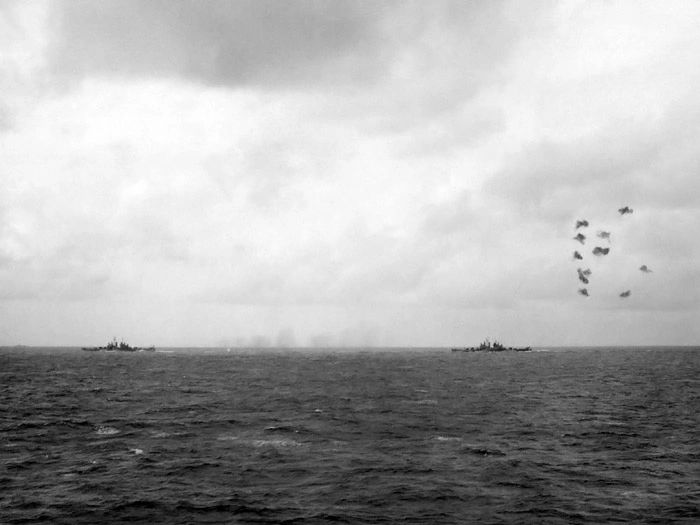
CruDiv 17 ships USS PASADENA (left) and WILKES-BARRE conduct AA drills along with ASTORIA on 26 January while en route to Ulithi Anchorage.
-photo taken by and courtesy of Herman Schnipper

Cruiser Division 17 steams in column into Mugai Channel upon return to Ulithi. USS WILKES-BARRE is the cruiser immediately behind ASTORIA. Note that ASTORIA only has one floatplane; the other is missing along with Senior Aviator Charles Tanner.
-photo taken by and courtesy of Herman Schnipper
With the return to Ulithi, Admiral Halsey and his staff handed the reigns of the Fast Carrier Task Force over to Admiral Spruance. 3rd Fleet officially became 5th Fleet, and Task Force 38 became Task Force 58, designations intended to confuse the enemy in thinking they belonged to separate fleets.
In his parting message to his Sailors and Marines, Admiral Halsey stated:
I am so proud of you that no words can express my feelings. This has been a hard operation. At times you have been driven almost beyond endurance but only because the stakes were high, the enemy was as weary as you were, and the lives of many Americans could be spared in later offensives if we did our work well now. We have driven the enemy off the sea and back to his inner defenses. Superlatively well done.
-Halsey.
CHAPTER 15: MOG MOG

BACK TO SHIP HISTORY
Sources:
Aman, Joseph. Joey Fubar's Cavalcade of Humor. Printed aboard USS ASTORIA CL-90, 1945.
http://commons.Wikimedia.org/wiki/Main_Page Wikimedia Commons image database.
http://earth.Google.com/ Google Earth.
Jones, Brent. Private photo and document collection.
MIGHTY NINETY: USS ASTORIA CL-90 cruise book. 1946.
Morison, Samuel Eliot. History of
Peddie, Jim. Private document collection.
Schnipper, Herman. Private photo and document collection.
Stafford, Edward P. The Big E. New York, NY: Random House, Inc., 1962.
